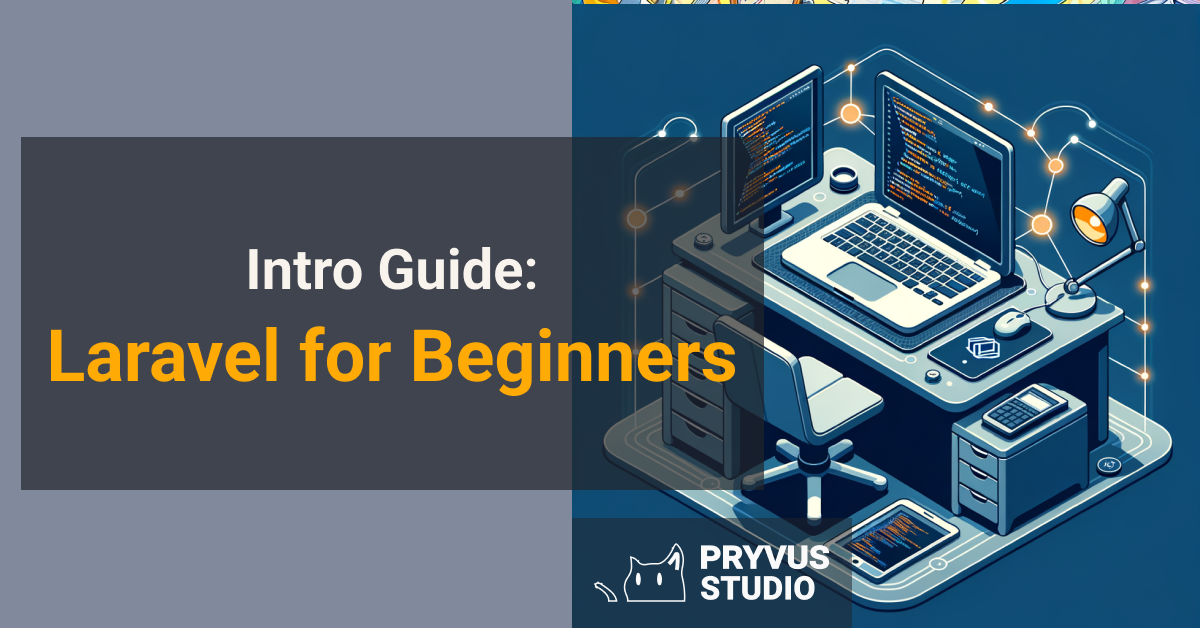Notice: Only variables should be passed by reference in /home/ploi/pryvus.com/public/wp-content/themes/pryvus/template-parts/content-post.php on line 12

Laravel, a PHP framework, is a powerful tool for web development.
It offers an elegant syntax, scalability, and a rich set of features, making it perfect for both beginners and seasoned developers. This article aims to provide a solid foundation for those starting with Laravel, highlighting its key advantages and how Pryvus Studio can enhance your development journey.
In this article, you will learn:
- How to set up and install Laravel
- The basics of MVC architecture in Laravel
- Security and authentication features in Laravel
Getting Started with Laravel: A Beginner’s Foundation
Laravel is a robust PHP framework designed for web artisans. It simplifies tasks like routing, authentication, and caching, making web development a breeze. If you’re new to Laravel, don’t worry. I’ll walk you through the basics to get you up and running.
Why Choose Laravel?
First off, Laravel is known for its elegant syntax. It’s built to make web development not just easier, but enjoyable. Laravel is also highly scalable, which means your Laravel-based project can grow with your needs. The framework has a rich set of features, including a powerful ORM, simple authentication, and a dynamic templating engine called Blade.
Setting Up Your Environment
Before diving into Laravel, ensure your development environment is ready. You’ll need PHP, Composer (a PHP package manager), and a local server environment. Laravel Valet (for Mac) and Laravel Homestead (a Vagrant box) are great choices for a seamless experience.
Installing Laravel
Installing Laravel is straightforward with Composer. Run the following command in your terminal:
composer create-project --prefer-dist laravel/laravel YourProjectName
This command creates a new Laravel project in the directory YourProjectName. Once installed, you can start the development server with:
php artisan serve
This will launch a server, allowing you to view your new Laravel site in the browser.
Exploring Laravel’s Directory Structure
Laravel has a specific directory structure, but you’ll spend most of your time in the app, resources, and routes directories. The app directory contains your core code. Resources hold views and uncompiled assets like LESS or SASS. Routes define URLs for your application.
Building Your First Web Page
Let’s create a simple web page. Laravel routes define URLs. Open the routes/web.php file and add:
Route::get('/', function () {
return 'Hello, world!';
});Now, when you visit your Laravel site’s root URL, you’ll see ‘Hello, world!’. Congratulations, you’ve built your first web page with Laravel!
In your journey, Pryvus Studio, with its extensive experience in custom software development and innovative solutions in web and mobile development, can be a valuable ally. Whether you’re tackling complex business challenges, streamlining processes, or unlocking new opportunities, understanding the basics of Laravel is a crucial first step.
To sum up, getting started with Laravel involves understanding its philosophy, setting up your environment, and taking your first steps into web development. With Laravel, you’re not just writing code; you’re crafting a masterpiece. Embrace the journey, and don’t hesitate to explore further.
Understanding MVC Architecture in Laravel
Laravel shines brightest when dissecting its MVC (Model-View-Controller) architecture. This design pattern is what makes Laravel exceptionally efficient for developers, especially beginners. Let’s dive deep into understanding each component and how they interact within Laravel.
Grasping MVC in Laravel is pivotal for leveraging its full potential in web development.

The Model is responsible for managing the data, logic, and rules of the application. In Laravel, models define relationships between different data objects, making database interactions intuitive.
The View component is all about the user interface. It’s where you get to shape the user’s experience, crafting what they see and interact with on the webpage.
The Controller acts as an intermediary, processing commands from the view, manipulating data using the model, and then passing the results back to the view. This separation of concerns within MVC makes Laravel applications easy to manage and scale.
Understanding MVC in Laravel not only simplifies web development but also empowers developers to build robust, efficient applications. With MVC, Laravel facilitates a clear workflow, which is crucial for beginners to get accustomed to professional web development practices.
Pryvus Studio leverages Laravel’s MVC architecture to deliver innovative solutions that meet and exceed client expectations. This approach streamlines processes, making development faster and more efficient.
Routing and Middleware: Navigating Laravel
Once you’ve dipped your toes into Laravel, it’s time to dive deeper into its core functionalities. A key aspect that sets Laravel apart is its approach to routing and middleware. These features are not just about moving from point A to B in your app but also about securing and optimizing the journey.
Mastering routing and middleware is essential for building robust and secure Laravel applications.
Let’s start with routing. In Laravel, routes are used to direct HTTP requests to their appropriate handlers. It’s like a map for your application, guiding users to the right content. Laravel makes routing simple yet flexible, allowing for closure-based routes, controller actions, and even group routes to streamline your application’s navigation.
But what about when you need to check if a user is authenticated or log requests? That’s where middleware comes in. Middleware acts as a filter for HTTP requests, enabling you to perform actions like authentication checks before the request even reaches its intended destination. Laravel comes packed with several middleware classes and allows you to create custom middleware, making your application more secure and efficient.
To get started with routing, define your routes in the routes/web.php file. Here, you can specify the URL, the controller, and the method to handle the request. Laravel’s expressive syntax makes defining routes straightforward. For example, a simple get request can be defined as Route::get('/welcome', function () { return 'Welcome to Laravel!'; });.
Middleware can be applied to routes or groups of routes to enforce authentication, log activities, or perform any preliminary checks. Applying middleware is as simple as adding the middleware method to your route definition, like Route::get('/profile', 'ProfileController@show')->middleware('auth');.
Understanding and utilizing routing and middleware effectively will not only make your Laravel applications more secure but also more adaptable to future changes. With Pryvus Studio’s expertise, navigating the intricacies of Laravel becomes a breeze, allowing you to focus on creating innovative solutions that exceed client expectations.
Database Migration and Eloquent ORM
When diving into Laravel, two features stand out for their power and flexibility: Database Migration and Eloquent ORM. These tools are crucial for managing your application’s database effectively and efficiently. Database migrations provide a version control system for your database, allowing you to modify and share the application’s database schema easily. Eloquent ORM, on the other hand, is an elegant ActiveRecord implementation for working with your database. It allows you to interact with your database objects and relationships using expressive, intuitive syntax.
Mastering Database Migration and Eloquent ORM is essential for any Laravel developer aiming to build robust, scalable applications.

Starting with Database Migrations, it’s all about keeping your database’s structure in sync with your application’s evolution. By defining migrations, you can create and modify tables without manually writing SQL queries. Each migration file is like a blueprint that specifies how to build or alter database tables.
Eloquent ORM simplifies data handling in your Laravel application. It links database tables to your models, making CRUD operations a breeze. Eloquent supports relationships, global scopes, and local scopes, offering a powerful way to manage your data.
- Define relationships easily between different database tables.
- Use scopes to apply common constraints to queries.
- Perform complex operations with simple, expressive syntax.
Integrating these features into your Laravel projects not only streamlines development but also enhances performance and security. Pryvus Studio leverages these Laravel capabilities to deliver tailored solutions that meet and exceed client expectations.
Authentication and Security Features in Laravel
When diving into web development with Laravel, understanding its authentication and security features is crucial. Laravel provides a robust set of tools to ensure your application is secure from common threats. From the get-go, Laravel’s built-in authentication system makes securing your application straightforward.
Mastering Laravel’s authentication and security features is essential for creating safe, reliable web applications.
Laravel’s security features are designed to protect against threats like SQL injection, cross-site request forgery (CSRF), and cross-site scripting (XSS). The framework uses hashed passwords, meaning the actual passwords are not stored in the database, adding an extra layer of security.
Authentication System
Laravel’s authentication system provides everything you need to implement user authentication. It includes features such as registration, login, and password reset. With Laravel’s built-in capabilities, adding authentication to your application is a breeze.
Security Practices
- SQL Injection Protection: Laravel uses PDO parameter binding to prevent SQL injection attacks.
- CSRF Protection: Laravel automatically generates and verifies CSRF tokens for each active user session, safeguarding against CSRF attacks.
- XSS Protection: Laravel’s blade templating engine automatically escapes output to prevent XSS attacks.
Implementing these security measures can significantly reduce vulnerabilities in your application. However, it’s also vital to stay updated on the latest security practices and threats. Laravel’s documentation and community forums are great resources for this.
In conclusion, Laravel’s built-in authentication and security features provide a solid foundation for building secure applications. By understanding and implementing these features, developers can ensure their Laravel applications are protected against common security threats. Pryvus Studio leverages Laravel’s capabilities to deliver secure, custom web solutions that exceed client expectations.
Testing and Deployment: Final Steps
Before launching your Laravel application, thorough testing and proper deployment are crucial. These final steps ensure your app works flawlessly across environments. Let’s dive into how you can achieve this with best practices and tools.
Effective testing and deployment set the stage for a successful Laravel project.

Unit and Feature Testing
Laravel provides built-in support for testing with PHPUnit. Start by writing unit tests for individual components and feature tests for user interactions. Use Laravel’s artisan command to generate test cases. Mocking and database transactions are your best allies here.
Integration and Browser Testing
For comprehensive testing, integrate third-party services and test browser compatibility. Laravel Dusk offers an expressive API for browser tests, ensuring your application behaves as expected on all major browsers.
Deployment Best Practices
- Use environment variables for configuration settings.
- Optimize your application for production with Laravel’s optimization commands.
- Automate deployments using CI/CD pipelines. Tools like Envoyer or Laravel Forge can simplify this process.
- Monitor your application’s health post-deployment with Laravel Telescope.
Remember, testing is an ongoing process. Even after deployment, keep testing for new features and updates. Pryvus Studio champions this meticulous approach to deliver projects that exceed client expectations.
The Path Forward with Laravel and Pryvus Studio
Embarking on your Laravel journey signifies the beginning of a promising development adventure. As you’ve seen, Laravel’s features from MVC architecture to advanced security, pave the way for robust web applications. But, it’s not just about the tools; it’s about how you use them. That’s where Pryvus Studio comes into play.
With Pryvus Studio, you’re not just getting a development team; you’re partnering with Laravel experts committed to bringing your vision to life. Our approach combines strategic planning, innovative solutions, and continuous support to ensure your project’s success.
Here’s what sets us apart:
- Deep understanding of Laravel’s capabilities
- Customized solutions tailored to your needs
- Commitment to quality and security
- Transparent communication throughout the development process
As you move forward, remember that the journey with Laravel is a marathon, not a sprint. Continuous learning, experimenting, and refining are part of the process. Pryvus Studio is here to guide you every step of the way, from initial setup to deployment and beyond.
Ready to take your web development to the next level with Laravel and Pryvus Studio? Let’s start building something amazing together. Reach out to us today to discuss your project and how we can help turn your ideas into reality.


